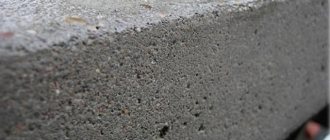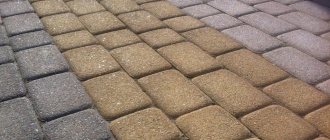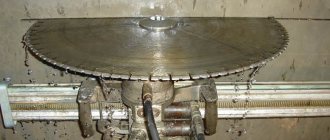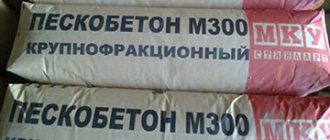The masonry mixture for bricks is selected depending on the conditions of the work, the type of construction project, the required strength characteristics, the required durability and a number of other factors. You can prepare such a solution yourself or buy it at a specialty store. Dry masonry mixture is sold in any hardware store, you can easily purchase it, but first it is important to determine how much dry material will be needed to produce the structure. The consumption of mortar per 1 m3 of masonry depends on many factors, so it must be determined in advance, before going for building materials.
Brands of masonry mixtures
Masonry mixtures act as an indispensable component in construction. They are usually classified into: calcareous; cement; cement-lime. These compositions differ from each other in strength, which is different for each brand. For example, a mixture of grade M50 is used for laying brick and stone. The solution contains lime and cement. This solution allows you to rid the surface of roughness. In addition, the pressure between the bricks and stones is distributed evenly. This masonry mixture is used to fill joints when building elements do not fit together. In the future, it is possible to achieve moisture resistance and durability of the building. This solution is most often used in low-rise construction. Its preparation is carried out on site.
MASONRY MORTAR FOR BRICK, ITS TYPES, MAIN CHARACTERISTICS AND AREAS OF APPLICATION.
Optimal - they can be used in different types of bricks during the construction of residential buildings or other buildings. Dry mixtures for masonry are divided into:
For laying standard building bricks, a crumbly cement-based masonry mixture with the addition of sand is best suited. There are also various additional additives for lime. They can significantly increase the storage time of the solution, improve its operating properties, but are not resistant to moisture.
- For laying bricks for cladding, it is better to use mixed compositions based on high-quality Portland cement, with an admixture of various modifiers that can provide the plasticity necessary for your solution, as well as moisture resistance and thermal conductivity.
- Today, the most popular masonry mixture is M 150. It gained its popularity due to its excellent performance properties, low water absorption, high resistance to sudden temperature changes (from minus to plus) and good heat insulation qualities. Colored masonry mixture for bricks will help in fully realize all your design ideas and solutions. Its use allows you to harmoniously combine the color of the brick and the seams between them. In order to make a similar mixture at home and with your own hands, you need to mix white cement for light colors, and gray for dark shades. That is, a white masonry mixture for bricks will be obtained if you mix white cement with water.
- Special mixtures are best used for the construction of large structures and their individual elements.
Compound
Masonry mortars are made of different compositions, taking into account the need for use in simple cases and in specific ones. Proportions and additives may vary even for interior and exterior work. Colored compositions used to create decorative effects may also differ in the percentage of binder material and auxiliary components, depending on the place of application.
Scheme of recommended compositions and their proportions depending on the purpose
The following excipients may be included in ready-made industrial formulations made for special applications:
- Fillers, the role of which in the standard mixture is played by sand. In other options, it may be sand mixed with fiber, gravel or crushed stone in concrete added when performing pouring work. The composition, which has the ability to retain heat and perform the function of thermal insulation, may contain polystyrene, perlite or expanded clay.
- Plasticizers - they are used to make masonry material elastic. But this is not the only goal for which plasticizers are included in the mixture. They increase adhesiveness (adhesion to the surface of the main structural element of the masonry) and thereby increase the characteristics of the mixture, the possibility of its easier use in work, and this improves the properties of the building, its reliability and service life.
- Hardeners are added if any mortar (including cement mortar for bricklaying) does not dry well. Most often, this phenomenon is associated with weather or climatic conditions. There are serious reasons to use such a component. This is a damp and humid climate, swampy area, and a building near the sea. This is necessary so that the result obtained when making a masonry mixture with an excess of hardener does not become an obstacle to the construction of a building, wall or structure.
- Antifreeze additives are the main condition for solving the problem of how to engage in construction at low temperatures. Knowing how to make bricklaying mortar frost-resistant, you can carry out work in winter or in conditions where the summer is short and the decrease in mercury is a constant feature of the climate.
- Dyes are a feature of the recipe only in the category that is designated in GOST as colored. Using visualization of seam and plaster for decorative purposes or to create a stylistic feature of an interior, facade or fence construction involves selecting a dye to add to masonry mixtures at the factory. The consumer can only choose the desired or similar shade.
Variety of types of prepared compositions and their proportions
There are many discussions on the question of whether water can be considered an auxiliary component of prepared building mixtures or whether it is one of the main ones, which are essentially groundless, because without water no solution can be prepared.
Consumption 1 m2
To obtain the most accurate amount of solution with minimal errors, a step-by-step calculation of consumption should be used. To do this, you need to calculate the area of the masonry (minus window and door openings), and then calculate the amount of mortar based on a third of a cubic meter of mixture for each cubic meter of area.
For example, it is necessary to erect a one-story building with a wall length of 15 meters and a ceiling height of 3.4 meters. There are seven windows measuring 1.8 x 1.2 meters and two doorways measuring 2.1 x 1.3 meters. In this case, an independent calculation of masonry with an internal thickness of 25 centimeters and an external thickness of 64 centimeters will look like this:
- total volume of external walls: 4 (walls) x 3.4 m x 15 m – 7 (windows) x 1.2 m x 1.8 m – 2 (doors) x 1.3 m x 2.1 m) x 0.64 m;
- total volume of internal walls: 42m x 3.4m – 5 x 1.3 x 2) x 0.25m;
- calculation of the ratio of aggregates and binders 4:1;
- calculation of the amount of cement.
In the vast majority of cases, the solution is mixed in the following proportions:
- 1 part cement;
- 3 parts of sifted sand;
- ½ part water.
To prepare the most popular brands of mortar, the following proportions of sand and cement are recommended:
- for the manufacture of grade M25: 5 to 1;
- for the manufacture of grade M50: 4 to 1;
- for the manufacture of grade M75: 3 to 1.
For example, to prepare an M25 mortar, you need to mix 2 tons of sifted sand, 0.26 tons of M400 cement and add 350 liters of water. It is necessary to take into account that the ratio of components may vary depending on external factors, including the location of work and soil and climatic conditions.
Attention: To cover walls with clinker facing bricks, it is necessary to use compounds of high viscosity, which can be increased using ground slag.
The table below shows standard material consumption standards depending on the thickness of the brickwork:
| masonry thickness, cm | consumption for single brick, kg | consumption for one and a half bricks, kg | consumption for double brick, kg |
| 12 | 30 | 24 | 18 |
| 25 | 78 | 66 | 54 |
| 38 | 126 | 108 | 90 |
Helpful Dosage Recommendations
It should be remembered that different types of building materials require mixing mixtures with different ratios of sand and cement for laying bricks. Solid brick requires one composition, and hollow brick requires another. Water for mixing should be used only clean, at a temperature of +15-20°C. If there is dirt or mold in it, it will show up later in the finishing. For cement-sand, the ratio of water to cement is as follows: 0.5-0.8 to 1 part of the binder component (depending on its brand). Sand is selected with a fraction of no more than 2.5 mm.
The proportions of cement consumption vary depending on its brand (the higher it is, the greater its viscosity). If M500 is used to mix the cement-sand composition, then 1 part of cement must be added to three parts of sand. For M400 their ratio will be different: 2.5 parts sand to 1 part binder component. The amount of sand can be greater, up to 8 parts - it depends on the purpose and brand of cement.
The finished mixture can be used within two hours, since after this the cement becomes less plastic and hardens. Therefore, you should mix exactly as much mortar as will be consumed on the masonry during this time.
How to cook it yourself?
First, the dry composition is mixed, sand is poured into the container, and then cement. It is better to sift everything first so that there are no lumps. The mixture is thoroughly mixed and water is added, after which everything is mixed again until the consistency becomes homogeneous. It is better to choose a container whose volume is almost the same as the amount of material required for a one-time job.
For greater strength and reliability, it is recommended to add detergent (50-100 g), it will increase its ductility. Cement consumption depends entirely on its brand. For 1 m3 you will need 510 kg of binder component grade M300, M200 - 410 kg, M150 - 330 kg. The consumption for masonry is affected by the building material used. For a solid brick it will be required less than for a hollow one. For 1 m2 of surface, about 0.2 m3 of composition is required for a single brick, and 0.25 m3 for a one-and-a-half brick.
A truly working legal way to save money. Everyone needs to know this!
How do you know if the mixture is mixed correctly and is ready?
You can determine the readiness of the cement mortar with your own hands using a cone or by touch.
You should pay attention to the degree of adhesion to the brick, as well as how mobile it is. Its readiness can be determined by making a dent in it: if its shape is maintained, then it is ready for use
You can also tilt the container by 40-45°, it should not leak out.
You can use a cone, its height and width are 15 cm, it weighs 300 g. The readiness of the composition is determined by immersing the cone in it. The depth of drowning depends on the purpose of the mixture. For an ordinary brick it should sink by 9-13 cm, for a hollow brick - by 7-8 cm, but no more.
The quality of the masonry mortar is determined by the amount of moisture in it and its plasticity. If it is too dry, it has weak adhesion to the building material, and if it is too damp, it spreads a lot. If it sticks to the trowel, then add the dry ingredients and mix everything thoroughly again. Mobility depends largely on the sand fraction: the smaller it is, the less mobile the composition.
Density can also be determined using a cone or by plasticity. If it spreads under its own weight, then it is not suitable for use; if it crumbles too much, then it also cannot be used for masonry.
Cost of ready-mixes
To avoid mixing by hand, you can buy masonry mortar. The use of such building materials greatly simplifies work and time costs, since there is no need to deal with dosing.
The purpose depends on the proportion of the binding component. Improperly prepared not only complicates the work, but also significantly deteriorates the quality of the structure being built. For example, a wall made from a poor-quality composition may become brittle and cracked. As a result, the heat capacity of the room decreases; in hot weather it quickly heats up, and in cold weather it cools down. When mixing the solution, you need to strictly follow the proportions. If they are disturbed, cracks may appear in the masonry.
DIY masonry mortar
How to make mortar for bricklaying with your own hands? To do this, it is necessary to determine the same characteristics of the installation process, and then select the proportions of cement, water, sand or lime and, if necessary, plasticizers. The preparation of such a mixture for bricks is identical to the preparation of a purchased composition. It is necessary to add a certain amount of water; when mixing a purchased mixture, the information is given on the packaging; when preparing the mixture yourself, the amount of water is taken according to the proportions.
A mixture for laying bricks can consist of several components: cement (grade M500), sand or lime, water and plasticizers. These components are mixed in a certain ratio, which gives the mixture the necessary qualities. The proportions of the masonry composition differ depending on the area of application. For example, grade M25 is intended for general construction work; to obtain it, you need to mix 1 part cement and 5 parts sand. The proportions of mortar for bricklaying (cement and sand) of 1:4 allows you to get a mortar of grade M50, 1:3 - M75. M50 and M75 are used for finishing walls with increased strength characteristics (maximum thickness - 0.25 m), structures of construction sites operated at high humidity, clinker elements, columnar foundations.
In addition, masonry mortar for bricks may contain lime, in which case the ratio of cement, sand and lime will be presented: 1: 4.5: 0.5 to obtain a mortar of grade M50, 1: 7: 0.8 - M75 and 1: 5.5:0.5 - M100. This composition is suitable for performing ground work, erecting walls made of bricks and large blocks, foundations with low moisture content of the load-bearing soil, filling cracks with a humidity of no more than 60%. The proportions of masonry mortar when preparing CSP with your own hands cannot be observed in strict accordance with the proportions, because There are some errors and deviations. However, they must be observed with the utmost precision; it is impossible to replace Portland cement grade M500 with grade M100, and as a result obtain comparable results.
How to prepare mortar for bricklaying? You need to add water to the concrete mixer, this can be half or a third of the norm, and mixed dry ingredients. The duration of the batch is determined depending on the volume of material to be processed. When working, the dough must be mixed every 15 minutes, which will prevent it from separating and setting in the open air.
Kneading
The following devices can be used to mix the DSP:
- Concrete mixer.
- Construction mixer.
- Shovel
It is important to consider that the mixture can only be used for its intended purpose during the first hour. Otherwise, it will harden and become unusable.
In order to save materials, you need to correctly calculate the volume of solution in order to rationally use the composition. Depending on the stage of repair or construction work, the DSP is diluted to the correct consistency.
If it is necessary to plaster the surface, the solution is given elasticity and cleaned of lumps or abrasive particles. Often a cement-lime composition is used, which is characterized by practicality.
Universal mixtures are in demand for the following tasks:
- Pouring concrete base.
- Construction of premises of varying complexity.
- Plastering.
- Masonry work.
- Sealing seams, voids and cracks.
The addition of additional components contributes to the emergence of the following operational advantages:
- Wear resistance.
- Water resistance.
- Resistance to negative temperatures.
- Strength.
- Reliability.
- Durability.
- High adhesive properties.
M75 brand mixture and its application
This solution is a high-class material in terms of super strength and water resistance. The composition is used in the construction of foundations and ground structures for industrial and public buildings. The mixture is excellent for laying blocks, preparing screeds, strengthening the foundation and leveling the floor. The material is a complex mixture, in the manufacturing process of which special equipment is used. If the outside air temperature is reduced at the time of hardening, this will make the curing period longer. You should also not increase the temperature, as the moisture will begin to evaporate too rapidly. Among the ingredients in the M75 brand mixture, the following should be highlighted: sand; cement; water. As for sand, the fraction should be 2.5 mm.
What to look for when purchasing
1 package. The bag must be double, sealed, without visible damage. If its walls are relatively thin (visible from the cut), this means that there may be a missing layer, which is called a “blotter cloth”. Such cement can be purchased only if the seller agrees to open the packaging so that the buyer can make sure that the product is completely dry. Moreover, when purchasing a batch, each bag must be inspected.
Sometimes you have to decide whether to buy bagged or loose cement. Please note that the latter option cannot guarantee the proper quality of the product, since it is not known under what conditions (humidity, temperature) it was stored.
2. Quality mark.
The ISO 9000 designation on the container indicates the product’s compliance with international standards. Unfortunately, there is cement on sale (usually loose cement), the origin of which is highly questionable. Using a self-propelled gun, for example, to prepare concrete mortar for a foundation, cannot lead to anything good. In this regard, it is worth asking the question, why are these products cheaper than their analogues? And if there is no certificate yet, then it is better to pass by, no matter how attractive the price. 3. Availability of additives. All substances used impart certain properties to the material (increase frost resistance, add plasticity to the finished product, and so on). Therefore, please clarify what exactly is this cement good for and is it needed for a specific application?
4. Date of manufacture. It is indicated on the container and in the accompanying documentation. All recommended ratios of component shares for mixtures are focused on fairly “fresh” cement (no more than 30 days), since its characteristics deteriorate over time. Up to 20% of properties are lost in about 3 months, in six months approximately 35 - 40%. Therefore, when purchasing “old” material, you need to be prepared for the fact that its consumption will increase.
5. Manufacturer. It is better if it is known at least in a given region. The “cement” business is quite a profitable business, and now there is quite a lot of specialization in it. But not all of them are “friendly” with technology, and many deliberately replace expensive components with cheaper ones. The packaging must contain information about the manufacturer (address, contact phone number). Its absence is a significant reason to doubt the quality of the product.
6. Price. Really good cement doesn't sell too cheap. Before going to the store, it is advisable to familiarize yourself with the average cost of the corresponding products in your region. This will help you avoid running into a fake.
1. There is an opinion that the higher the grade of cement, the better. This is nothing more than a misconception. For those maximum loads to which a private structure will be subjected, products up to M500 are quite suitable, and then only for load-bearing structural elements. By purchasing material of higher grades, inexperienced developers are literally throwing money away.
2. Before starting any work using cement, it is necessary to accurately determine the volume of purchase. People who have no experience believe that it is better to purchase it with some reserve, just in case. In this case, such a point as the shelf life of the material is overlooked. At the same time, it is better to use cement from the same batch. If you then purchase it in addition, it is not a fact that all its properties will be identical to the previously purchased binder. This can lead to heterogeneity in the structure of the artificial stone and a decrease in its strength.
3. If you purchase a loose product, you need to make sure of its quality. It is enough to take a small handful of cement and then unclench your fingers. If the material does not bunch up, but “flows” between them, then the product is good. The color is also indicative. If it is too dark (which means the cement is saturated with moisture), then it is better to refuse the purchase.
Application of M100 mixture
Masonry mixture M100 is today one of the most popular among other types of mortars. The composition is used in the construction of urban and industrial buildings. The material is excellent for laying external stone floors, brick columns, internal partitions and various blocks. The solution is waterproof, so it can be used to make plaster. The mixture is suitable for laying gypsum tiles, mosaics and leveling surfaces. The material consists of water, sand and cement. The sand fraction can vary from 0.5 to 1 mm. Due to the filler, the stability of the solution increases. To improve workability and increase softness, aqueous emulsions and plasticizers are added to the ingredients, the first of which can delay the hardening of the composition.
A mixture of grades M125, 150 and 200
The masonry mixture for bricks M125 is suitable for the construction of walls made of stone and various blocks. The composition for laying gypsum tiles is often used. The fraction of sand used can vary from 0.5 to 1 mm. The M150 grade mixture is characterized by increased hardness. The material is suitable for masonry, and in domestic construction it is used for ceramics and finishing concrete structures. This mixture is good in that it is not sensitive to low temperatures, but requires adherence to a temperature range ranging from +5 to +35 °C during the work process. Heat-resistant masonry mixture M200 is characterized by its refractoriness and water-repellent characteristics. Use washed mountain sand without organic compounds for preparation. Among other things, shells and limestone fragments are used, the fraction of which is approximately 3 mm.
HOW TO DETERMINE IF THE SOLUTION IS PREPARED CORRECTLY?
If the solution is made according to all the rules, then it has the appearance of thick sour cream. Checking its quality is very simple: you need to take a little of the resulting mixture on the tip of a shovel and see how it spreads (if the solution spreads slowly, this means that it is of high quality).
How to choose good cement for different purposes?
On this issue, people who do not have a specialized education can argue endlessly.
And a professional, before discussing this topic, will definitely clarify for what purposes it is better? And he will be absolutely right. Cement is one of the most used materials. It is used as a binder in the process of preparing mixtures for mortars that are used in various types of work, be it repairs (reconstruction) or construction. But in order to buy really good cement in all respects, you need to understand the range of these products and their labeling.
To make the task easier, it is worth noting that many types of material are specific for their application and are not used in the private sector. Therefore, we will focus only on products in the “general purpose” category. In the private sector, Portland cement (PC) is mainly used as it is more universal in use; in some cases, Portland slag cement (SPC) is used.
Let's look at the main parameters that you should pay attention to first.
It is marked with the letter “M”. The number after it characterizes the strength of cement (in kg/cm 3 ). In the field of individual construction, the most popular grades are from 50 to 400, in some cases 450 and 500. Cements with higher values are used only for special objects.
Letter "D". The next figure or number (from 0 to 20) indicates the percentage of substances introduced into the mixture.
In what cases and which cement is better?
The base of any structure is the most loaded part. During the preparatory work, you can use grades of cement “100” or “150”. For foundations for small objects (garage, summer kitchen, fence and a number of others), M200 is sufficient.
When constructing residential buildings, concrete grade no lower than “200” is used. Based on this, cement M400 or 500 is taken (the latter is somewhat more expensive, but has better characteristics).
When determining which cement to choose for bricklaying, you need to take into account the purpose of this structural element. If the wall is load-bearing, then it is better to prepare a mixture based on M400 binder. For less loaded applications (in a residential building), the M300 is also suitable. When constructing a small building (shed, garage, gazebo, etc.), there is only one requirement - at least M200.
Nowadays, most developers, in order to reduce costs, independently produce some building materials, for example, paving or facing slabs. For such samples, it is better to take M300 cement, as the most universal brand.
Good quality of such a layer will be ensured if you take cement grade “300” or “400”. The latter is more expensive and is used if the solution is prepared for outdoor use.
4. Blind area, screed
Considering the cost of cement, you can get by from “50” to “150”. If we are talking about floors, then the specific brand is determined based on the specifics of the room (load on the surface, intensity of movement of goods and people, etc.).
In all other cases (for example, for sealing cracks, coating surfaces), this characteristic of cement is not particularly important. As a rule, the owner uses the material that is at hand.
Color mixtures
Modern houses are increasingly becoming colored; this has become possible to achieve thanks to pigments. Today, dark or white cement is used, which is supplemented with polymers and dyes. The production produces a wide range of shades, they can be, for example, rich green. Polymer additives fix the composition, so the seams do not change color even under the influence of precipitation. Today, a white masonry mixture is produced for bricks; fine-grained sand is used as a filler, which is supplemented with polymers. This ensures low water absorption and high plasticity. Different shades of the mixture allow you to combine the color of the brick and seams, embodying bold design solutions. If you use this composition only for jointing, you will be able to reduce consumption. An example is the masonry mixture PEREL SL 0001, which has a snow-white hue.











